Siyu Tang
TransforMARS: Fault-Tolerant Self-Reconfiguration for Arbitrarily Shaped Modular Aerial Robot Systems
Sep 17, 2025Abstract:Modular Aerial Robot Systems (MARS) consist of multiple drone modules that are physically bound together to form a single structure for flight. Exploiting structural redundancy, MARS can be reconfigured into different formations to mitigate unit or rotor failures and maintain stable flight. Prior work on MARS self-reconfiguration has solely focused on maximizing controllability margins to tolerate a single rotor or unit fault for rectangular-shaped MARS. We propose TransforMARS, a general fault-tolerant reconfiguration framework that transforms arbitrarily shaped MARS under multiple rotor and unit faults while ensuring continuous in-air stability. Specifically, we develop algorithms to first identify and construct minimum controllable assemblies containing faulty units. We then plan feasible disassembly-assembly sequences to transport MARS units or subassemblies to form target configuration. Our approach enables more flexible and practical feasible reconfiguration. We validate TransforMARS in challenging arbitrarily shaped MARS configurations, demonstrating substantial improvements over prior works in both the capacity of handling diverse configurations and the number of faults tolerated. The videos and source code of this work are available at the anonymous repository: https://anonymous.4open.science/r/TransforMARS-1030/
Multi-View 3D Point Tracking
Aug 28, 2025Abstract:We introduce the first data-driven multi-view 3D point tracker, designed to track arbitrary points in dynamic scenes using multiple camera views. Unlike existing monocular trackers, which struggle with depth ambiguities and occlusion, or prior multi-camera methods that require over 20 cameras and tedious per-sequence optimization, our feed-forward model directly predicts 3D correspondences using a practical number of cameras (e.g., four), enabling robust and accurate online tracking. Given known camera poses and either sensor-based or estimated multi-view depth, our tracker fuses multi-view features into a unified point cloud and applies k-nearest-neighbors correlation alongside a transformer-based update to reliably estimate long-range 3D correspondences, even under occlusion. We train on 5K synthetic multi-view Kubric sequences and evaluate on two real-world benchmarks: Panoptic Studio and DexYCB, achieving median trajectory errors of 3.1 cm and 2.0 cm, respectively. Our method generalizes well to diverse camera setups of 1-8 views with varying vantage points and video lengths of 24-150 frames. By releasing our tracker alongside training and evaluation datasets, we aim to set a new standard for multi-view 3D tracking research and provide a practical tool for real-world applications. Project page available at https://ethz-vlg.github.io/mvtracker.
Spline Deformation Field
Jul 10, 2025
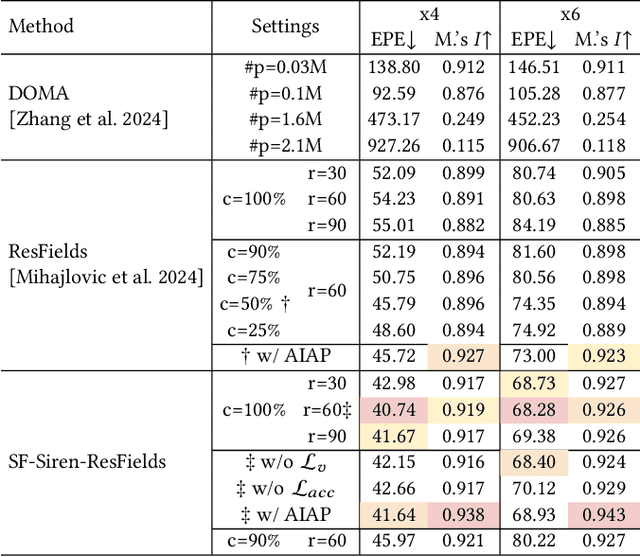

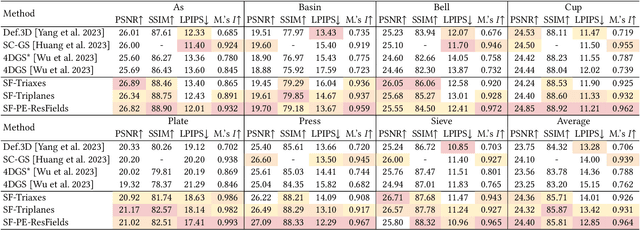
Abstract:Trajectory modeling of dense points usually employs implicit deformation fields, represented as neural networks that map coordinates to relate canonical spatial positions to temporal offsets. However, the inductive biases inherent in neural networks can hinder spatial coherence in ill-posed scenarios. Current methods focus either on enhancing encoding strategies for deformation fields, often resulting in opaque and less intuitive models, or adopt explicit techniques like linear blend skinning, which rely on heuristic-based node initialization. Additionally, the potential of implicit representations for interpolating sparse temporal signals remains under-explored. To address these challenges, we propose a spline-based trajectory representation, where the number of knots explicitly determines the degrees of freedom. This approach enables efficient analytical derivation of velocities, preserving spatial coherence and accelerations, while mitigating temporal fluctuations. To model knot characteristics in both spatial and temporal domains, we introduce a novel low-rank time-variant spatial encoding, replacing conventional coupled spatiotemporal techniques. Our method demonstrates superior performance in temporal interpolation for fitting continuous fields with sparse inputs. Furthermore, it achieves competitive dynamic scene reconstruction quality compared to state-of-the-art methods while enhancing motion coherence without relying on linear blend skinning or as-rigid-as-possible constraints.
EgoM2P: Egocentric Multimodal Multitask Pretraining
Jun 09, 2025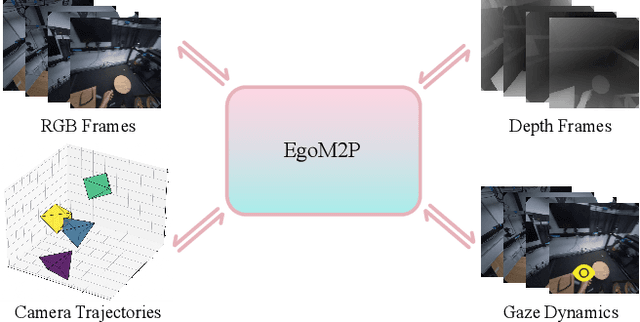
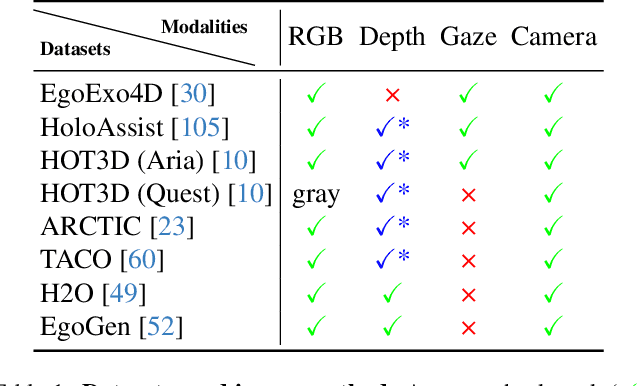
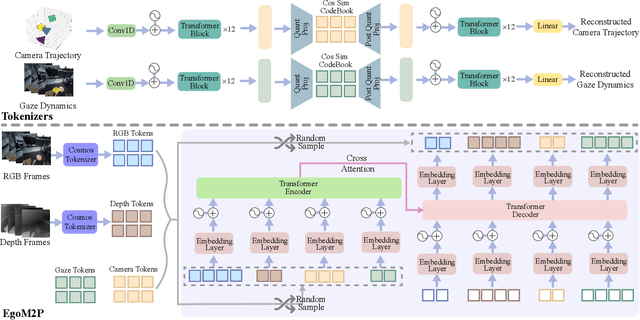
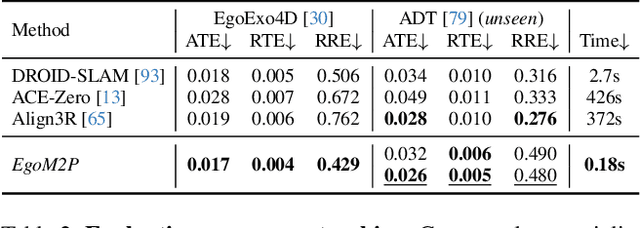
Abstract:Understanding multimodal signals in egocentric vision, such as RGB video, depth, camera poses, and gaze, is essential for applications in augmented reality, robotics, and human-computer interaction. These capabilities enable systems to better interpret the camera wearer's actions, intentions, and surrounding environment. However, building large-scale egocentric multimodal and multitask models presents unique challenges. Egocentric data are inherently heterogeneous, with large variations in modality coverage across devices and settings. Generating pseudo-labels for missing modalities, such as gaze or head-mounted camera trajectories, is often infeasible, making standard supervised learning approaches difficult to scale. Furthermore, dynamic camera motion and the complex temporal and spatial structure of first-person video pose additional challenges for the direct application of existing multimodal foundation models. To address these challenges, we introduce a set of efficient temporal tokenizers and propose EgoM2P, a masked modeling framework that learns from temporally aware multimodal tokens to train a large, general-purpose model for egocentric 4D understanding. This unified design supports multitasking across diverse egocentric perception and synthesis tasks, including gaze prediction, egocentric camera tracking, and monocular depth estimation from egocentric video. EgoM2P also serves as a generative model for conditional egocentric video synthesis. Across these tasks, EgoM2P matches or outperforms specialist models while being an order of magnitude faster. We will fully open-source EgoM2P to support the community and advance egocentric vision research. Project page: https://egom2p.github.io/
Text-based Animatable 3D Avatars with Morphable Model Alignment
Apr 22, 2025Abstract:The generation of high-quality, animatable 3D head avatars from text has enormous potential in content creation applications such as games, movies, and embodied virtual assistants. Current text-to-3D generation methods typically combine parametric head models with 2D diffusion models using score distillation sampling to produce 3D-consistent results. However, they struggle to synthesize realistic details and suffer from misalignments between the appearance and the driving parametric model, resulting in unnatural animation results. We discovered that these limitations stem from ambiguities in the 2D diffusion predictions during 3D avatar distillation, specifically: i) the avatar's appearance and geometry is underconstrained by the text input, and ii) the semantic alignment between the predictions and the parametric head model is insufficient because the diffusion model alone cannot incorporate information from the parametric model. In this work, we propose a novel framework, AnimPortrait3D, for text-based realistic animatable 3DGS avatar generation with morphable model alignment, and introduce two key strategies to address these challenges. First, we tackle appearance and geometry ambiguities by utilizing prior information from a pretrained text-to-3D model to initialize a 3D avatar with robust appearance, geometry, and rigging relationships to the morphable model. Second, we refine the initial 3D avatar for dynamic expressions using a ControlNet that is conditioned on semantic and normal maps of the morphable model to ensure accurate alignment. As a result, our method outperforms existing approaches in terms of synthesis quality, alignment, and animation fidelity. Our experiments show that the proposed method advances the state of the art in text-based, animatable 3D head avatar generation.
UniPhys: Unified Planner and Controller with Diffusion for Flexible Physics-Based Character Control
Apr 17, 2025Abstract:Generating natural and physically plausible character motion remains challenging, particularly for long-horizon control with diverse guidance signals. While prior work combines high-level diffusion-based motion planners with low-level physics controllers, these systems suffer from domain gaps that degrade motion quality and require task-specific fine-tuning. To tackle this problem, we introduce UniPhys, a diffusion-based behavior cloning framework that unifies motion planning and control into a single model. UniPhys enables flexible, expressive character motion conditioned on multi-modal inputs such as text, trajectories, and goals. To address accumulated prediction errors over long sequences, UniPhys is trained with the Diffusion Forcing paradigm, learning to denoise noisy motion histories and handle discrepancies introduced by the physics simulator. This design allows UniPhys to robustly generate physically plausible, long-horizon motions. Through guided sampling, UniPhys generalizes to a wide range of control signals, including unseen ones, without requiring task-specific fine-tuning. Experiments show that UniPhys outperforms prior methods in motion naturalness, generalization, and robustness across diverse control tasks.
DNF-Avatar: Distilling Neural Fields for Real-time Animatable Avatar Relighting
Apr 14, 2025Abstract:Creating relightable and animatable human avatars from monocular videos is a rising research topic with a range of applications, e.g. virtual reality, sports, and video games. Previous works utilize neural fields together with physically based rendering (PBR), to estimate geometry and disentangle appearance properties of human avatars. However, one drawback of these methods is the slow rendering speed due to the expensive Monte Carlo ray tracing. To tackle this problem, we proposed to distill the knowledge from implicit neural fields (teacher) to explicit 2D Gaussian splatting (student) representation to take advantage of the fast rasterization property of Gaussian splatting. To avoid ray-tracing, we employ the split-sum approximation for PBR appearance. We also propose novel part-wise ambient occlusion probes for shadow computation. Shadow prediction is achieved by querying these probes only once per pixel, which paves the way for real-time relighting of avatars. These techniques combined give high-quality relighting results with realistic shadow effects. Our experiments demonstrate that the proposed student model achieves comparable or even better relighting results with our teacher model while being 370 times faster at inference time, achieving a 67 FPS rendering speed.
SplatVoxel: History-Aware Novel View Streaming without Temporal Training
Mar 18, 2025Abstract:We study the problem of novel view streaming from sparse-view videos, which aims to generate a continuous sequence of high-quality, temporally consistent novel views as new input frames arrive. However, existing novel view synthesis methods struggle with temporal coherence and visual fidelity, leading to flickering and inconsistency. To address these challenges, we introduce history-awareness, leveraging previous frames to reconstruct the scene and improve quality and stability. We propose a hybrid splat-voxel feed-forward scene reconstruction approach that combines Gaussian Splatting to propagate information over time, with a hierarchical voxel grid for temporal fusion. Gaussian primitives are efficiently warped over time using a motion graph that extends 2D tracking models to 3D motion, while a sparse voxel transformer integrates new temporal observations in an error-aware manner. Crucially, our method does not require training on multi-view video datasets, which are currently limited in size and diversity, and can be directly applied to sparse-view video streams in a history-aware manner at inference time. Our approach achieves state-of-the-art performance in both static and streaming scene reconstruction, effectively reducing temporal artifacts and visual artifacts while running at interactive rates (15 fps with 350ms delay) on a single H100 GPU. Project Page: https://19reborn.github.io/SplatVoxel/
DeGauss: Dynamic-Static Decomposition with Gaussian Splatting for Distractor-free 3D Reconstruction
Mar 17, 2025
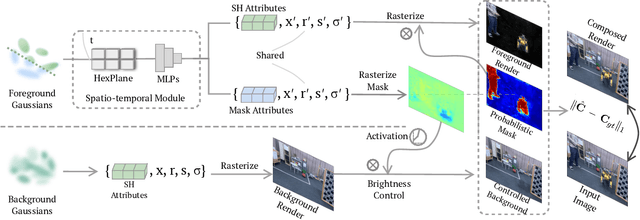

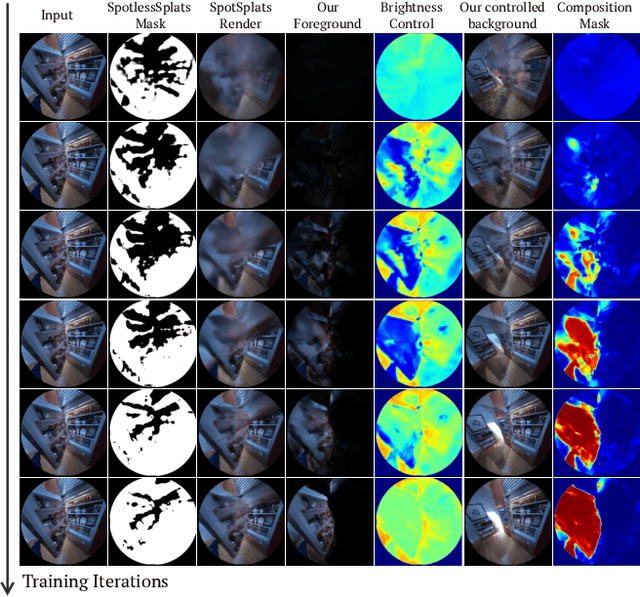
Abstract:Reconstructing clean, distractor-free 3D scenes from real-world captures remains a significant challenge, particularly in highly dynamic and cluttered settings such as egocentric videos. To tackle this problem, we introduce DeGauss, a simple and robust self-supervised framework for dynamic scene reconstruction based on a decoupled dynamic-static Gaussian Splatting design. DeGauss models dynamic elements with foreground Gaussians and static content with background Gaussians, using a probabilistic mask to coordinate their composition and enable independent yet complementary optimization. DeGauss generalizes robustly across a wide range of real-world scenarios, from casual image collections to long, dynamic egocentric videos, without relying on complex heuristics or extensive supervision. Experiments on benchmarks including NeRF-on-the-go, ADT, AEA, Hot3D, and EPIC-Fields demonstrate that DeGauss consistently outperforms existing methods, establishing a strong baseline for generalizable, distractor-free 3D reconstructionin highly dynamic, interaction-rich environments.
Robust Self-Reconfiguration for Fault-Tolerant Control of Modular Aerial Robot Systems
Mar 12, 2025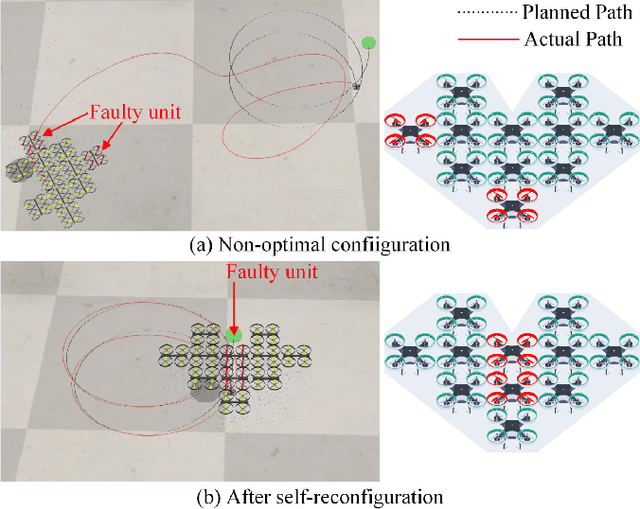
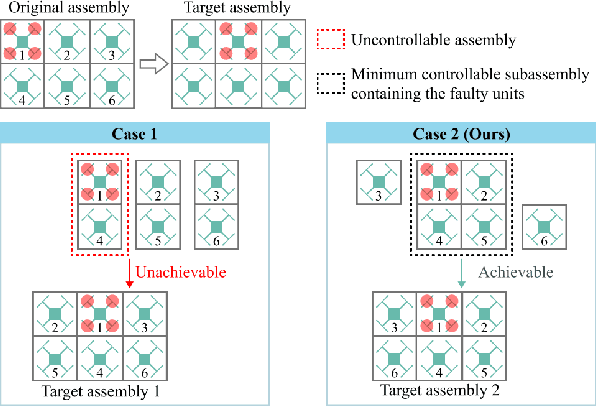
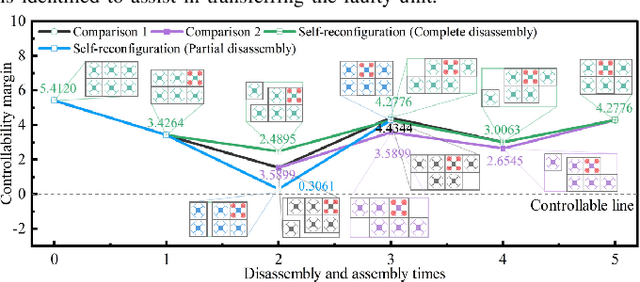
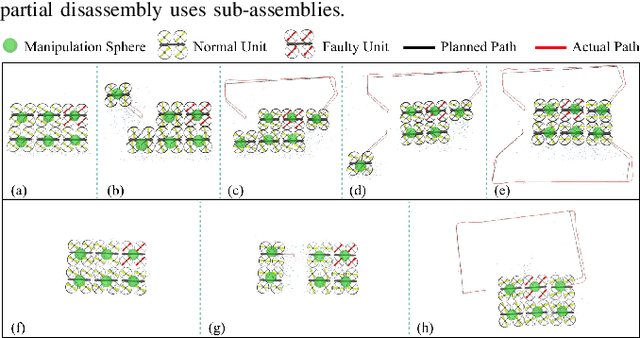
Abstract:Modular Aerial Robotic Systems (MARS) consist of multiple drone units assembled into a single, integrated rigid flying platform. With inherent redundancy, MARS can self-reconfigure into different configurations to mitigate rotor or unit failures and maintain stable flight. However, existing works on MARS self-reconfiguration often overlook the practical controllability of intermediate structures formed during the reassembly process, which limits their applicability. In this paper, we address this gap by considering the control-constrained dynamic model of MARS and proposing a robust and efficient self-reconstruction algorithm that maximizes the controllability margin at each intermediate stage. Specifically, we develop algorithms to compute optimal, controllable disassembly and assembly sequences, enabling robust self-reconfiguration. Finally, we validate our method in several challenging fault-tolerant self-reconfiguration scenarios, demonstrating significant improvements in both controllability and trajectory tracking while reducing the number of assembly steps. The videos and source code of this work are available at https://github.com/RuiHuangNUS/MARS-Reconfig/
 Add to Chrome
Add to Chrome Add to Firefox
Add to Firefox Add to Edge
Add to Edge